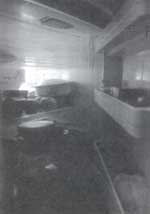Air cooled
 ALL those campaigns finally paid off Scientists recently confirmed that the global use of chloroflurocarbons (CFCs) has shown an encouraging downward trend. CFCs suddenly attracted a lot of public, media and scientific attention in the 1980s, when it was discovered that these chemicals had torn a huge hole in the Earth's ozone layer. CFCs are industrial chemicals used as coolants predominantly by the refrigeration industry. Till a few years back, our fridges had CFCs in them. And many still do. But now, British engineers and US researchers have developed a new refrigeration system that uses air as coolant and truly provides a CFC free alternative to coolants. The technology could come into our own homes, or rather into our fridges soon.
ALL those campaigns finally paid off Scientists recently confirmed that the global use of chloroflurocarbons (CFCs) has shown an encouraging downward trend. CFCs suddenly attracted a lot of public, media and scientific attention in the 1980s, when it was discovered that these chemicals had torn a huge hole in the Earth's ozone layer. CFCs are industrial chemicals used as coolants predominantly by the refrigeration industry. Till a few years back, our fridges had CFCs in them. And many still do. But now, British engineers and US researchers have developed a new refrigeration system that uses air as coolant and truly provides a CFC free alternative to coolants. The technology could come into our own homes, or rather into our fridges soon.
Since ozone-unfriendly CFCs are being gradually phased out as per the terms of the 1987 Montreal Protocol, most refrigeration system manufacturers have opted for alternative coolants. Most of these, however, are no better. Hydrocarbons like pentene are flammable, while others, such as hydrachlorofluorocarbons (HCFCs) are potent greenhouse gases.
This prompted engineers from UK-based Air Products and Chemicals to team up with refrigeration experts at Toromont Process Systems of Houston in Texas, USA, to develop a new system that uses air as coolant. They were not attempting anything new. Air has been used as a coolant before, but inefficiently. Some of the earliest fridges, very few of them even dating back to the 19th century, depended on rapid expansion of compressed air for cooling. However, the central problem with these early coolers was that the air could (and usually did) escape into the atmosphere.
Things work differently in the new refrigeration system, though the basic principle remains largely unchanged. It recycles the air, forming a closed cycle air refrigeration (CCAR) system. The CCAR system runs at higher pressures, and this improves it efficiency.
An air fridge has a few moving parts, just a compressor and an expander at opposite ends of the same electrically powered drove shaft. The compressor pressurises air in the refrigeration circuit, which heats it up. This heat is removed by passing the air through a heat exchanger cooled by water. The expander forces the cool, compressed air to expand rapidly, making it cold enough for refrigeration (New Scientist, Vol 159, No 2152).
The prototype that the engineers have come up with is "competitively efficient at temperatures below -50 C, - which is an industrially useful temperature - says Peter Callingham, product manager at Air Products, The unit is also half the size of the conventional ammonia-based refrigerators, which cools to -40 c, and can cool to a much lower -73 c. The hot water that is generated as a by-product need not go waste. It could, suggests Callingham, be used to warm swimming pools.
Related Content
- State of the global climate 2023
- India's journey towards sustainable cooling
- Global cooling watch 2023
- Restoring mountain ecosystems: challenges, case studies and recommendations for implementing the UN Decade Principles for Mountain Ecosystem Restoration
- Combating black carbon for clean air and climate
- Unlocking floating solar photovoltaics potential in India
